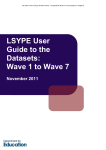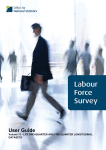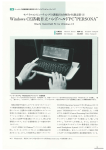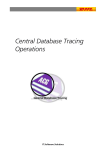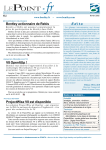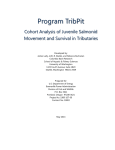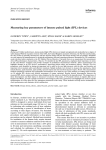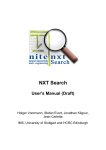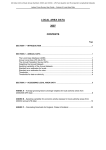Download User Guide - UK Data Service
Transcript
International Passenger Survey Overseas Travel and Tourism Data Sets - User Guide UK Data Archive Study Number 6846 - International Passenger Survey, 2011 Contents Page 1 Introduction Page 4 Travelpac Page 13 More detailed, disaggregated IPS datasets International Passenger Survey Datasets User Guide Introduction The International Passenger Survey (IPS) is conducted by the Office for National Statistics. One of the main uses of the data is production of estimates relating to overseas travel and tourism (visits and earnings to the UK/expenditure) ONS publishes ‘Overseas Travel and Tourism’ topline estimates on a monthly basis, followed by more detailed analysis on a quarterly and annual basis The IPS data that is held by UK Data Service relates only to overseas travel and tourism. It is of two types: 1. An aggregated data set ‘TravelPac’ which allows users to replicate quarterly estimates contained in the ONS Overseas Travel and Tourism publications 2. Disaggregated datasets containing a selection of important variables that allow users to conduct more detailed analysis of international travel patterns, excluding migration. This user guide provides the user with key details about the survey and instructions of how to use the datasets Note that one further key use of the IPS is to produce estimates of international migration. However, the data placed with UK Data Service does not include information relating to migration. Any queries or wishes to access data for the purpose of international migration analysis should be directed to [email protected]. 1 International Passenger Survey Datasets User Guide About the International Passenger Survey The International Passenger Survey is a continuous survey of international passengers conducted at all major ports and routes into the UK. It has been running since 1961. An indepth description of the IPS methodology can be found at http://www.ons.gov.uk/ons/guidemethod/method-quality/specific/travel-and-transport-methodology/international-passenger-surveymethodology/index.html The survey is multi-purpose. One of its main purposes is to provide estimates of international migration to and from the UK. The IPS sample size for that purpose is approximately 800,000 contacts with sampled passengers a year. Another main purpose is provision of overseas travel and tourism estimates. The IPS sample size for that purpose is approximately 250,000 a year. The data sets housed at UK Data Service relate to the overseas travel and tourism estimates, i.e. sample size of approximately 250,000 a year. No variables relating to international migration are included. Further information about the IPS and further overseas travel and tourism analyses can be obtained from Office for National Statistics International Passenger Survey Room 2201 Government Buildings Cardiff Road Newport NP10 8XG Telephone +44 (0) 1633 455678 E-mail [email protected] 2 International Passenger Survey Datasets Published with the permission of the Controller of Her Majesty’s Stationery Office (HMSO). © Crown copyright 2010 ISBN 1 85774 606 6 User Guide The Government Statistical Service The Government Statistical Service (GSS) is a network of professional statisticians and their staff operating both within the Office for National Statistics and across more than 30 other government departments and agencies. For re-use of this material you must apply for a Click-Use Public Sector Information (PSI) Licence from: Office of Public Sector Information, Crown Copyright Licensing and Public Sector Information, Kew, Richmond, Surrey, TW9 4DU Tel: 020 8876 3444 www.opsi.gov.uk/click-use/index.htm Contacts For information, contact the IPS Survey Team: Tel: 01633 455277 Email: [email protected] Other customer enquiries ONS Customer Contact Centre Tel: 0845 601 3034 International: +44 (0)845 601 3034 Minicom: 01633 812399 Email: [email protected] Fax: 01633 652747 Post: Room 1015, Government Office Buildings, Cardiff Road, Newport, South Wales NP10 8XG www.ons.gov.uk Media enquiries Tel: 0845 604 1858 Email: [email protected] The Office for National Statistics The Office for National Statistics (ONS) is the executive office of the UK Statistics Authority, a non-ministerial department which reports directly to Parliament. ONS is the UK government’s single largest statistical producer. It compiles information about the UK’s society and economy, and provides the evidence-base for policy and decision-making, the allocation of resources, and public accountability. The Director-General of ONS reports directly to the National Statistician who is the Authority's Chief Executive and the Head of the Government Statistical Service. 3 International Passenger Survey Datasets User Guide 1. Travelpac What is Travelpac? Travelpac is provided as a series of data files in both Excel and SPSS formats which allow users to examine the results in far greater depth than is possible from traditional printed sources. Data are available through the UK Data service, and on the ONS website for each year from 1993 onwards http://www.ons.gov.uk/ons/publications/all-releases.html?definition=tcm%3A77-21827 About the Travelpac datasets Travelpac contains information gathered from people who were interviewed on the IPS on the 1 return leg of their journey, i.e. mainflow passengers Furthermore, Travelpac contains data 2. only for a subgroup of these travellers termed tourists This selection ensures results from Travelpac will be in keeping with other published overseas travel and tourism information. Key publications from ONS using this data are as follows: Title 1 Travel Trends: An annual report on the International Passenger Survey Website location http://www.ons.gov.uk/ons/rel/ott/traveltrends/2010/index.html 2 Monthly Overseas Travel & Tourism Statistical Bulletin http://www.ons.gov.uk/ons/publications/allreleases.html?definition=tcm%3A77-21824 3 Quarterly Overseas Travel & Tourism http://www.ons.gov.uk/ons/publications/allreleases.html?definition=tcm%3A77-21825 All the variables in Travelpac datasets have been re-coded from the full IPS database. The data are then aggregated to form a highly efficient yet compact data file. This enables Travelpac data files to be used with most modern spreadsheets and statistical packages. While some detail within some of the categories is inevitably lost during the aggregation process, the information considered to be most important remains available for analysis. The Travelpac variables Travelpac is a simplified version of the IPS database containing 14 of the most widely used categorical and continuous variables. The categorical variables give counts of trips falling into various categories, and include the year or the quarter. Variables are described below. Travelpac continuous variables VISITS shows how many visits are represented by a particular record. The values can be summed to give the total number of visits. A visit is a complete round trip, e.g. for UK residents it represents both a departure and an arrival in the UK. On the IPS overseas residents’ visits are actually measured at the time of their departure from the UK, while UK residents’ visits abroad are measured at the time of their arrival back to the UK. NIGHTS relates to the total number of nights spent whilst on a visit. In the full IPS dataset, each record has its own NIGHTS variable, representing the nights stayed for that record. In 3 Travelpac datasets, the nights have been weighted and summed together so one row in a dataset can represent the total nights for one or more actual IPS interviews. Summing the values given in the NIGHTS variable will produce the number of nights spent on all visits. SPEND shows the total expenditure made abroad (for UK residents) or in the UK (for overseas residents) during the visit. Amounts are given in £UK at current prices, i.e. the value 4 International Passenger Survey Datasets User Guide of money at the time the visits were made. As with NIGHTS, the data are already weighted and so can be summed to give spending estimates. SAMPLE is the number of contacts from the main IPS used to support each row of information in the Travelpac dataset. This can be used as an indication of the reliability of the data being examined. For simplicity and convenience, the values of all continuous variables in Travelpac files have been limited to three places of decimals. This means at extreme levels, results produced by summing values may differ marginally from IPS information produced or published elsewhere. Travelpac categorical variables Variable Description Codes and labels YEAR Year of interview Coded as 4 digit year QUARTER Period of year 1 2 3 4 Jan–Mar Apr–Jun Jul–Sep Oct–Dec UKOS Where contact lives 1 2 UK residents Overseas residents MODE Main method of travel 1 2 3 Air Sea Tunnel PURPOSE Main purpose of visit 1 2 3 4 5 6 Holiday Business Study VFR (visit friends or relatives) 4 Miscellaneous 5 Transits PACKAGE Package or independent 1 2 Independent Non-Independent (i.e. package trip) SEX Sex of respondent 1 2 9 Male Female Sex unknown (not recorded) AGE Age group of respondent 1 2 3 4 5 6 7 9 0–15 16–24 25–34 35–44 45–54 55–64 65 & over Age not known DURATION Length of the visit 0 1 2 3 4 5 6 9 Nil Stay 1–3 nights 4–13 nights 14–27 nights 28–90 nights 91–182 nights (3-6 months) 183 nights – 1 year Stay not known 5 International Passenger Survey Datasets User Guide COUNTRY Place of residence for overseas residents or of visit for UK residents Europe 10 11 12 13 14 15 16 17 18 19 20 21 22 23 24 25 26 27 28 29 30 31 32 33 34 35 36 37 38 39 40 41 42 43 44 45 Austria Belgium Bulgaria Croatia Czech Republic Cyprus EU Cyprus Non EU Denmark Estonia Finland France Germany Gibraltar Greece Hungary Iceland 6 Irish Republic Italy Latvia Lithuania Luxembourg Malta Netherlands Norway Poland Portugal Romania Russia Spain Slovakia Slovenia Sweden Switzerland Turkey 7 Channel Islands Other Europe Africa 50 51 52 53 54 Egypt Tunisia Other North Africa South Africa Other Africa Middle East 60 61 62 Israel United Arab Emirates Other Middle East Asia 70 71 72 73 74 75 76 77 China – Hong Kong China – Other India Japan Pakistan Sri Lanka Thailand Other Asia 6 International Passenger Survey Datasets User Guide America and Caribbean 80 81 82 83 84 85 86 Canada USA Mexico Other Central & South America Barbados Jamaica Other Caribbean Rest of the world 90 91 92 Australia New Zealand Other countries Most countries are uniquely identified by the COUNTRY variable. However, to ensure that analyses will be compatible with other ONS overseas travel and tourism published information, some codes in the country variable include more than one country depending on sovereignty. Care should be taken where more than one country is included under a single title. The combined countries presented in this database are: Category of COUNTRY Additional territories included France Monaco Italy San Marino and Vatican City Portugal Azores and Madeira Spain Andorra, Canary Islands Switzerland Liechtenstein Other Europe Bosnia Herzegovina, Croatia, Macedonia, Montenegro, Serbia, Albania, Armenia, Azerbaijan, Byelorussia, Georgia, Kazakhstan, Kirghizia, Moldavia, Tadzhikistan, Turkmenistan, Ukraine and Uzbekistan Other North Africa Algeria, Libya, Morocco, Sudan and South Sudan Other Africa All other continental Africa plus Antarctic, Madagascar, Equatorial Guinea and Eritrea Canada Greenland and St. Pierre et Miquelon USA Puerto Rico and US Virgin Islands Israel Palestine Other Middle East Bahrain, Iran, Iraq, Jordan, Kuwait, Lebanon, Oman, Qatar, Saudi Arabia, Syria and Yemen China Tibet Other Asia Afghanistan, Bangladesh, Bhutan, Borneo, Brunei, Burma, Cambodia, Celebes, Timor (E&W), Indonesia, Korea (N&S), Labuan Islands, Laos, Macao, Malaysia, Mongolia, Nepal, Philippines, Sabah, Sarawak, Singapore, Taiwan, Tibet and Vietnam Other countries Rest of Pacific, country unknown and UK residents on 8 cruises 7 International Passenger Survey Datasets User Guide Cyprus Since the expansion of the European Union in May 2004, Cyprus has uniquely been coded in two parts to allow members of the new EU to be identified. Before May 2004 a single code for Cyprus is used. Understanding Travelpac datasets The cases in the datasets are aggregated (or grouped) by the categorical variables. For example, in the first line of the dataset in the 2011 dataset, there is one case in quarter 1 (January to March) of a female UK resident aged 0-15 travelling by air to Austria on an independent holiday which lasts for 4-13 nights. The next row has four cases (male; aged 16 – 24) with a similar profile. Estimates for visits, nights and spend represent weighted data. Using Travelpac datasets Users will need to select suitable software to perform analyses from Travelpac files. Two formats of data file are provided to give users a choice of software for analysis. For SPSS® users The datasets are supplied as SPSS SAV files which can also be read and used in SAS®. The files are fully labelled thus making data tabulation very easy using the SPSS TABLES or CTABLES modules. For spreadsheet users Files are provided in Microsoft Excel® format. Each file contains three worksheets, one in numeric format and another in a fully labelled format. The third worksheet contains metadata which gives a description of the variables. The files are compatible with versions of Excel from Excel 97 onwards. Note that Excel files may not import fully into other spreadsheets (including earlier versions of Excel) due to the row limitations of some packages. Quarterly and annual Travelpac datasets IPS data are released by quarter to a pre-announced timetable and at the same time new Travelpac files will be made available on the National Statistics website. The latest files will contain records for the current year to date and their status will be flagged as “provisional” as results will be revised later in the year. Once IPS data are finalised and released each year, new annual Travelpac files will replace ones marked as provisional. The following Travelpac datasets will be made available: Quarter 1 Quarter 2 Quarter 3 Quarter 4 Full year available mid April mid July mid October mid January year+1 July year+1, at which point the quarterly datasets should not be used. 8 International Passenger Survey Datasets User Guide Data analysis Most types of analysis can be performed in simple cross tabulations or nested tabulations. In the following example it is assumed we want to find out how many visits were made to the UK by overseas residents in the current year, their expenditure, the reason why they travelled, in what period of the year, and whether they were on a package trip or travelled independently. This requires an analysis of the variables VISITS and SPEND according to YEAR, QUARTER, UKOS, PURPOSE and PACKAGE. Example using SPSS (Versions 7 onwards) First the SPSS file for the current year is loaded into SPSS. Then run the following syntax to create the data. In later versions of SPSS the new CTABLES command could also be used. var lab purpose "". var lab visits"". var lab spend "". var lab package "". var lab quarter "". var lab ukos "". var lab year "". tables /observation visits spend /table purpose>package>(visits+spend) by quarter by ukos> year /statistics sum(visits "Visits" (comma9.0)) sum(spend "Spend" (comma9.0)). Note that the syntax will in fact produce two pages of tabulation – one for UK residents and Ov ers eas residents 2009 Holiday Independent Non-Independent Busines s Independent Non-Independent Study Independent Non-Independent VFR Independent Non-Independent Miscellaneous Independent Non-Independent Transit Independent Visits Spend Visits Spend Visits Spend Visits Spend Visits Spend Visits Spend Visits Spend Visits Spend Visits Spend Visits Spend Visits Spend Jan-Mar 1, 727, 903 921,729,343 274,702 128,987,586 1, 566, 737 835,820,139 6, 649 6, 951, 009 68, 796 169,700,292 18, 920 20, 662, 221 1, 959, 052 839,863,107 7, 396 4, 548, 363 541,031 252,240,743 41, 598 33, 858, 325 . 6, 458, 865 Apr-Jun 2, 590, 339 1431172516 734,265 335,847,784 1, 674, 374 893,368,552 12, 347 8, 424, 796 80, 319 241,141,993 18, 757 22, 855, 215 2, 171, 746 838,081,730 3, 831 3, 410, 095 609,241 295,215,170 47, 467 17, 370, 412 . 10, 059, 709 Jul-Sep Oct -Dec 3, 235, 015 1, 986, 720 1969769056 1, 077, 495, 311 559,916 315,517 349,150,634 161,661,839 1, 593, 392 1, 699, 717 914,793,748 1, 012, 092, 330 14, 356 11, 089 7, 630, 216 7, 290, 002 155,593 99, 249 472,093,276 312,179,175 53, 723 7, 726 123,464,841 8, 091, 052 2, 460, 013 2, 168, 957 1150599567 935,322,638 3, 325 8, 608 5, 486, 910 3, 528, 858 669,590 602,617 391,852,255 307,603,943 35, 119 53, 366 19, 914, 337 24, 424, 940 . . 13, 077, 711 6, 469, 027 one for overseas residents. Output from the latter is shown overleaf. 9 International Passenger Survey Datasets User Guide Example using Excel (Versions from 97 onwards) The same analysis can be conducted using the pivot tables feature of Excel. The Excel pivot table data selection is illustrated below. It shows how the analysis variables should be entered into the table specification to produce output similar to that of the SPSS example. purpose Business package Independent Non-Independent Holiday Independent Non-Independent Miscellaneous Independent Non-Independent Study Independent Non-Independent Transit Independent VFR Independent Non-Independent Data Sum of visits Sum of spend Sum of visits Sum of spend Sum of visits Sum of spend Sum of visits Sum of spend Sum of visits Sum of spend Sum of visits Sum of spend Sum of visits Sum of spend Sum of visits Sum of spend Sum of visits Sum of spend Sum of visits Sum of spend Sum of visits Sum of spend ukos Year quarter Overseas residents 2009 Apr-Jun Jan-Mar Jul-Sep Oct-Dec 1674374 1566737 1593392 1699717 893368552 835820139 914793748 1012092330 12347 6649 14356 11089 8424796 6951009 7630216 7290002 2590339 1727903 3235015 1986720 1431172516 921729343 1969769056 1077495311 734265 274702 559916 315517 335847784 128987586 349150634 161661839 609241 541031 669590 602617 295215170 252240743 391852255 307603943 47467 41598 35119 53366 17370412 33858325 19914337 24424940 80319 68796 155593 99249 241141993 169700292 472093276 312179175 18757 18920 53723 7726 22855215 20662221 123464841 8091052 0 0 0 0 10059709 6458865 13077711 6469027 2171746 1959052 2460013 2168957 838081730 839863107 1150599567 935322638 3831 7396 3325 8608 3410095 4548363 5486910 3528858 Note that the variables in the Excel pivot table are listed in alphabetical order and not, as in the SPSS example, in the order in which they are coded. If tabulations in code order are required, you will need to use the numeric versions of the data files. However, if you do this you will then lose all the labels information. 10 International Passenger Survey Datasets User Guide When used correctly, tabulations made using Travelpac data files will give results which are in keeping with the IPS information published in the latest editions of Travel Trends and Quarterly Overseas Travel and Tourism. IPS definitions 1 MAINFLOW This term describes passengers who are on the return leg of their trip and includes UK residents returning to the UK and overseas residents leaving the UK. Passengers who are beginning their trip are termed ‘contraflow’. Travelpac and other published tourism estimates are based on information from mainflow rather than contraflow passengers (though contraflow estimates are important for IPS weighting). This is because it is not until the end of passengers’ trips that information about their visits can be collected reliably. 2 TOURISTS Published IPS tourism information always relates to tourists. In IPS datasets, a tourist is considered to be a person whose trip does not exceed a year. A tourist does not include a person who is migrating, military personnel on duty, or crews of aircraft travelling to collect/deliver craft. Tourists do include people on business trips, students and those looking for work or travelling for medical treatment. 3 WEIGHT Each record of a Travelpac dataset represents visits made by people interviewed on the IPS who have similar characteristics. A number, or weight, is then applied to each record so that it correctly represents the actual number of trips made by people with those characteristics. The values given in the SPEND and NIGHTS variables are also weighted and can be summed to give totals of expenditure or nights spent. By simple division, the weighted variables can be used to calculate new variables such as average length of stay, average expenditure per visit and average expenditure per day. 4 MISCELLANEOUS Visits for miscellaneous purposes include travel to attend sporting events, for shopping, health, religious or other purposes, together with visits for more than one purpose when none predominates (e.g. visits both on business and on holiday). Overseas visitors staying overnight in the UK en route to other destinations are also included in the miscellaneous purposes category. 5 TRANSITS Some records are coded as ‘transit’ under purpose of visit. This applies to overseas residents who arrive at an airport and cross the IPS counting line but are not visiting the UK. Their purpose of visit is to change planes and they leave the UK again during the same day. These cases are not counted as tourist visits to the UK but their expenditure is included within tourist spending. Transit cases therefore have values in the SPEND variable but are coded as zero in the VISITS and NIGHTS variables. People who visit the UK to change flight but stay overnight are included as tourists and coded under the ‘miscellaneous’ category of PURPOSE. 6 IRISH RECORDS Until 1999, the IPS did not interview on routes to the Irish Republic and so there was no sample for travel to or from this country for these years. The main IPS sample was supplemented by ‘pseudo’ records which represented the estimated total number of visits to and from this country. Therefore, prior to this change, much of the categorical data relating to visits to or from the Irish Republic is coded as ‘unknown’. From 1999 onwards, full information appears for the passengers travelling to and from ports in the Irish Republic. 7 CHANNEL ISLANDS Apart from YEAR, QUARTER and MODE, IPS datasets only contain information on SPEND for visitors to and from the Channel Islands. All such spending is assumed to be for holiday purposes. 8 CRUISE RECORDS Due to the difficulty in interviewing for cruise trips, only very basic information exists for UK residents on cruises and so this sector are included with “Other Countries”. 11 International Passenger Survey Datasets User Guide 2. More detailed disaggregated IPS overseas travel and tourism datasets 2.1 QContact This dataset contains one record for each of the (approximately 250,000 a year) people interviewed on the broader (excluding migration) IPS each year. A description of key variables and how they impact on usage is as follows. Note that this description is not in the exact same order that variables appear in the dataset. Variable Quality Description The data file includes all cases, regardless of how much information was provided to the interviewer. Codes 3 ‘Completes’ and 4 ‘Partials’ are used in analysis. A Complete interview is one for which all key information was provided; a Partial is one for which some information was missing and values may have been imputed. Code 5 ‘Minimum’ are not of particular use for analysis, because they are not included in final visit estimates. They are a form of non response and are included in the data set to enable the user to identify what proportion of people travelling to/residing in a particular country refused to give more than minimal information Serial Year Qtr Month Flow Res Residence Cty This is a unique identifier which may help the user when working with the data Year in which the interview took place Quarter in which the interview took place (e.g. ‘2’ relates to ‘April to June’ Month in which the interview took place (e.g. ‘4’ relates to April) There are eight ‘flows’, as follows: 1. Overseas residents departing UK via air 2. UK residents departing UK via air 3. Overseas residents arriving in UK via air 4. UK residents arriving in UK via air 5. Overseas residents departing UK via sea or tunnel 6. UK residents departing UK via sea or tunnel 7. Overseas residents arriving in UK via sea or tunnel 8. UK residents arriving in UK via sea or tunnel The overseas travel and tourism estimates published by ONS use only flows 1,4,5,8, i.e. those on which the visit is being completed. These cases contain a range of detail about the visit This is the code for the country in which any overseas respondent lives. The names of the countries can be identified via checking the variable ‘residence’ or the ‘Country Codes’ (reference ‘Old Code’) under documentation on UK Data service website http://www.esds.ac.uk/findingData/snDescription.asp?sn=7087 This is the name of the country of residence This is the code for the main country visited on a trip abroad by a UK resident. The names of the countries can be identified via checking the variable ‘CountryVisit’ or the ‘Country Codes’ (reference ‘Old Code’) under documentation on UK Data service website http://www.esds.ac.uk/findingData/snDescription.asp?sn=7087 12 International Passenger Survey Datasets CountryVisit Nation Nationality Purp Purpose County Age Sex Ukport Transfer Port1 AirportCode Port2 User Guide This is the name of the main country visited on a trip abroad by a UK resident This is the code for the country that the respondent is a national of. The names of the countries can be identified via checking the variable ‘Nationality’ or the ‘Country Codes’ (reference ‘Old Code’) under documentation on UK Data service website http://www.esds.ac.uk/findingData/snDescription.asp?sn=7087 This is the name of the country which the respondent is a national of. If a respondent has dual nationality, the nationality which is recorded is the country which issued the passport being used to travel with on the day of interview. This is the main purpose of visit for this trip. Response options are labelled There are two variables for purpose, one containing an ‘old’ code and one ‘new’. This is merely because some ONS analyses use the old code and some the new. Either ‘Purp’ or ‘Purpose’ can be used. This is the code for the town in which UK residents live. The variable affords users the opportunity of analysing where people from different regions of the UK are travelling to. The names of the towns can be identified via checking the ‘UK Town Codes’ spreadsheet under documentation on UK Data service website http://www.esds.ac.uk/findingData/snDescription.asp?sn=7087 Age band of the respondent Sex of the respondent The port in the UK or the ferry/tunnel route at which the respondent was interviewed is given a code. The names of the port or route can be identified via checking the ‘UK Port Codes’ spreadsheet under documentation on UK Data service website http://www.esds.ac.uk/findingData/snDescription.asp?sn=7087 Note that some sea routes have the same codes as some airports. If a user is referencing this variable it is important to filter the analysis, using the variable ‘flow’ This variable identifies whether the respondent flew to the UK direct or changed planes This is the code for the overseas port to which the respondent is immediately flying to/started this flight at. The names of the ports can be identified via referencing the name given in the variable ‘AirportCode’ checking the ‘International Port Codes’ spreadsheet under documentation on UK Data service website http://www.esds.ac.uk/findingData/snDescription.asp?sn=7087 This is the name of the port which the respondents has flown from/will fly to from UK This is the code for the overseas port to which the respondent is ultimately flying/started their trip at. The names of the ports can be identified via referencing the name given in the variable ‘ChangeCode’ checking the ‘International Port Codes’ spreadsheet under documentation on UK Data service website http://www.esds.ac.uk/findingData/snDescription.asp?sn=7087 13 International Passenger Survey Datasets ChangeCode UKLeg OVleg Directleg Carrier1 FlPrefix FlSuffix Bustick Flightyp Vehicle Vehno Fare Haul Persons expppv netexp Spend ind shift Stay fweight User Guide This is the name of the port which the respondents has ultimately flown from/will fly to from UK, i.e. before/after any change of planes This is the mileage from the UK port to the port immediately travelled from/to (‘Port1) This is the mileage from the Port 2 to Port1 for anyone who changes planes This is the total mileage from the UK port to the final destination/source port overseas This is the code for the carrier operating the flight travelled on. The names of the carriers can be identified via checking the ‘Airline Codes’ spreadsheet under documentation on UK Data service website http://www.esds.ac.uk/findingData/snDescription.asp?sn=7087 This variable provides the 2-letter carrier prefix This variable provides the flight suffix. By combining the variables Flprefix and Flsuffix the user can create the flight code This variable identifies whether the respondent travelled on a business ticket paid for by a company. It is asked only to UK residents arriving in the UK Was the flight arrived on/leaving on private, charter or schedule? Passengers travelling by sea are asked whether they are travelling with a vehicle, and if so what sort of vehicle This is the number of people, including the driver, in the vehicle travelled in (asked of certain vehicle types only) This is the cost of a single fare for each respondent. Fares are asked only of UK residents arriving in the UK, all other cases are imputed Whether the flight was short haul or long haul During the interview the respondent is asked about expenditure for the full group of people travelling with him or her. ‘Persons’ details how many people are included in the travelling/’expenditure’ group. This is the amount of money spent in relation to this visit either prior to the visit (e.g. coach trips, tickets) or still to be paid when the respondent gets home. It relates to actual transactions rather than any unpaid credit card bills This value includes all money spent before the trip, during it and afterwards. It is presented as relating to the full travelling/expenditure group (‘Persons’). This is the total amount of money spent before, during and after the trip expressed in terms of the respondent alone, in other words ‘netexp’ divided by ‘Persons’. This variable identifies whether the trip was a ‘package’ i.e. in which the cost of the fare and accommodation could not be separated. Note: in any cases where the trip was a package the ‘spend’ is imputed through a process of estimating the fare and removing that from the total cost of the package (minus travel agent fees) as expressed in the variable ‘itcost’ Whether the interview took place am (up to 14:00hrs), pm (up to 22:00 hrs) or at night Length of stay expressed in number of nights. The weight attached to this case. In other words, how many passengers this respondent represents when producing estimates. 14 International Passenger Survey Datasets User Guide Some other variables are included in the data set but relate to ONS purposes. If users require more details they should contact ONS via the contact details provided above. 2.2 QRegTown (or ‘QReg’) This dataset also contains one record for each eligible respondent interviewed. However, it is different to Qcontact in that: It contains only overseas residents who visited the UK (flows 1 and 5). There is no weight relating to each respondent. It can be linked to QContact to produce estimates of visits to individual parts of the UK. However, some information may not have been provided by the respondent about towns visited, hence analysis will not match the ONS overseas Travel and Tourism estimates. As such, this dataset is provided to allow users to understand the raw data collected on IPS and to make any ad hoc analysis on this raw data. If users require a data set that will match the ONS Overseas Travel and tourism datasets they should contact ONS via the contact details provided above. ONS points out that steps are being taken to place an imputed regional dataset with UK data service. The variables in QRegTown are as follows: Variable Serial Year Qtr Month Flow Town1 Stay1 Accom1 Spend1 Description This is a unique identifier which may help the user when working with the data and match to the QContact dataset Year in which the interview took place Quarter in which the interview took place (e.g. ‘2’ relates to ‘April to June’ Quarter in which the interview took place (e.g. ‘4’ relates to April) There are eight ‘flows’, as follows: 1. Overseas residents departing UK via air 2. UK residents departing UK via air 3. Overseas residents arriving in UK via air 4. UK residents arriving in UK via air 5. Overseas residents departing UK via sea or tunnel 6. UK residents departing UK via sea or tunnel 7. Overseas residents arriving in UK via sea or tunnel 8. UK residents arriving in UK via sea or tunnel The overseas travel and tourism estimates published by ONS use only flows 1,4,5,8, i.e. those on which the visit is being completed. These cases contain a range of detail about the visit The first town which the respondent mentioned s/he stayed in overnight on this visit to the UK The names of the towns can be identified via checking the ‘UK Town Codes’ spreadsheet under documentation on UK Data service website http://www.esds.ac.uk/findingData/snDescription.asp?sn=7087 The number of nights stayed in town1 The types of accommodation stayed in in town1 The estimates amount of money spent in town1 Note that each of Town1, Stay1, Accom1 and Spend1 is repeated for up to eight towns stayed in during this visit. 15 International Passenger Survey Datasets 2.3 User Guide AirMiles This dataset is provided as a small data set from which mileage can be analysed. It employs a subset of variables described under section 2.1 QContact. Note that ONS is in the processing of producing a reduced set of data sets, and will not produce this file going forward. 2.4 Alcohol This data set contains information about money spent on alcohol and tobacco. As per the AirMiles file, it will not be provided going forward. 16


















